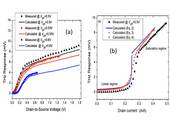Highlight
Terahertz response of field-effect transistors in saturation regime
Achievement/Results
IGERT trainee William Stillman and IGERT faculty Michael S. Shur, professor of Electrical Engineering and IGERT faculty X.-C. Zhang, Professor of Physics, Rensselaer Polytechnic Institute, Troy, NY and their international collaborators reported on the broadband terahertz response of InGaAs/GaAs high electron mobility transistors operating at 1.63 THz and room temperature deep in the saturation regime. They demonstrated that responses show linear increase with drain-to-source voltage (or drain-bias current) and might reach very high values up to 170 V/W. They also develop a phenomenological theory valid both in the Ohmic and in the saturation regimes.
Prof. Shur and his colleague predicted in 1993 that dc current in the field effect transistor (FET) channel, might become unstable. The instability results in the generation of plasma waves with fundamental frequency, which can be tuned by the gate voltage into the THz range. As a consequence, FET should emit a THz radiation. They also showed that nonlinear properties of the FET channel in particular, nonlinear dependence of the local current in the channel from the local gate-to-channel voltage may be used for detection of THz radiation.
Figure 1a shows the measured and calculated broadband THz response of InGaAs/GaAs high electron mobility transistors (HEMTs) at 1.63 THz as a function of the drain-to-source voltage for different gate-bias voltages. This THz radiation was produced by an optically pumped far-infrared gas laser polarized parallel to the transistor channel and modulated by an optical chopper with a fixed frequency of 100 Hz and focused with normal incidence on the transistor surface. The responses start to grow linearly when transistor is driven deeper in the saturation regime. Figure 1b shows measured and calculated THz response as a function of the drain current for a gate bias of 0.5 V. The linear responsivity in the saturation regime appears clearly on the proper linear scale. Calculation (Equation 4) matches the responses in all regimes very well.
The discovery of linear response of FETs in the saturation regime offers many advantages for THz detection and imaging applications: THz responsivity can be increased by two to four times when transistors operate deeper in the saturation regime and an additional increase in responsivity may be gained when many transistors are connected in series. Also, the saturation regime can be used for imaging the incident THz radiation at subwavelength resolution. It keeps the US in a leading position of nanoelectronics and engineering. For more details of calculations, please see Applied Physics Letters 98 (24) 243505 (2011).
Address Goals
In the process of testing of the FET devices, the IGERT faculty and trainees learned to work together with domestic and international collaborators, and developed deeper understanding of the linear response of FETs in the saturation regime as well as disseminated findings to society through journal publications and professional conferences.






